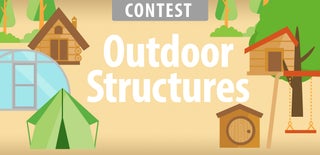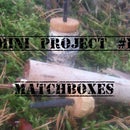Introduction: "Survival" Fishing Shelter
This summer I decided to challange myself with building a shelter using only materials you can find in the woods, paracord and a knife, hence the "Survival" in the title. I built the shelter at my usual fishing spot so I wouldn't get wet when it rained while I was fishing.
If you want to do something similar keep in mind that you might have to ask the landowner for permisson to build on his land and taking materials. Here in Sweden (and Norway I believe) we have a law called "Allemansrätten" which allows you to walk in the woods even if the land is owned by someone. You can pick berries, mushrooms, sticks, branches (depends on the size of the branch) and other types of plants. I also talked to the landowner to make sure it would be fine, becouse I used leftover branches from a nearby clearing.
So make sure you have permisson by the landowner before attempting to do something like this.
Also, I'm in no way an expert in the subject of survival shelters. Take everything you read in this Instructable with a pinch of salt. Everything I learned comes from my "mentors" (more like other outdoors enthusiasts) and books.
With that out of the way let's get into the Instructable!
(Also keep in mind that english is not my native language so grammatical and spelling errors will occur)
Step 1: Find a Spot
This part was easy for me. I already knew where I wanted to build the shelter. Choose the spot with great care becouse you won't be able to move the shelter later.
My spot is a little bit uneven, but the view is great!
Step 2: The Framework
For the frame I used four spruce wood poles that was about 2.5 meters long (8.2 feet), but I later found out they were too long. But becouse I only had a knife I didn't bother to make them any shorter.
I dug two holes in the water that was about 30 cm (1 feet) deep where the poles would go. When the poles where in place I "reinforced" the holes with rocks. I made sure to fill every gap with pebbles and put heavier rocks on top so they wouldn't move. I would have liked to use gravel instead of pebbles, but I couldn't find any gravel.
When I chose my location for my shelter I made sure to have tree nearby that could be a part of the frame. So I tied the other poles between the tree and the vertical poles. Becouse I'm terrible at knots (both at the names and actually tying them) I will show pictures instead. I wrapped the paracord around the tree and used the same knot as the one in picture nine. I then wrapped the paracord around the pole back in an under over pattern so it went back to the direction it came from. Brought the paracord 360° around the tree and did the same thing on the other side. I used the same method when I tied the horizontal poles to the vertical ones (picture ten).
Step 3: A Place to Sit
I'm no stranger to fish standing but it's more comfortable to sit, especially when you angle. I used softer woods for the floor, mainly birch and beech. The softer woods are much easier to cut than, for example, spruce. When cuting the branches to your desired length you cut the branch like in picture two and then do the same thing from the other direction. When the branch is thin enough you should be able to just bend it until it breakes. I also removed the twigs from the branches, making them more comfortable to sit on.
I then took the thickest branch and tied it to the end of the horizontal poles. I couldn't do it earlier becouse I did everything alone. If you have someone that helps you can tie the branch to the poles while tying the poles to each other (if that made senes). Next I just filled the gap between the tree and the branch with the other branches. When everything was in place I started to tie the branches to the poles. I'm not going to try explaining how I did it, hopefully they will be clear enough (in picture 12 I took the paracord under the pole and up over the the branch making the X pattern). The last picture just shows the knot I used at the start and end of the pattern.
Step 4: Don't Want to Get Wet
A roof was probably not entirely necessary considering the shelter is placed under a pine, I just don't want to get wet when it rains (which it does a lot during the swedish summer). I didn't use spruce for the frame, mostly becouse I couldn't find any but it would also have been a pain to tie them to the tree becouse of their weight. So I used two thick beech branches. Same procedure as with the poles, but luckily I didn't need as much paracord. When I had the roof branches in place I laid the rest of the branches like you see in the pictures. To make the roof waterproof I used ferns as roof tiles. Ferns grow like weed where I live so they weren't hard to come by. I would have prefered reeds or a special type of grass that are better at keeping water away, but I took what was easy to find. As you can see the roof is well sealed, except for some tiny spots.
Step 5: End Result
I know it's not the most beautiful thing in the world, but it works. I would have liked to add walls but my paracord ran out and there weren't many branches left at the clearing.
Hopefully you have enjoyed this Instructable feel free to comment down below, feedback is always appreciated.
OutdoorEnthusiast out.

Participated in the
DIY Summer Camp Challenge

Participated in the
Outdoor Structures Contest

Participated in the
Outside Contest 2016













